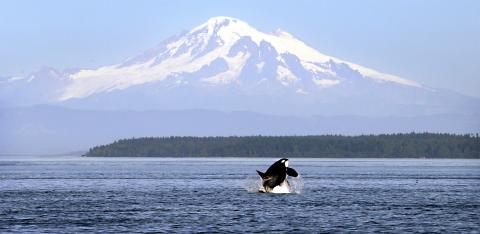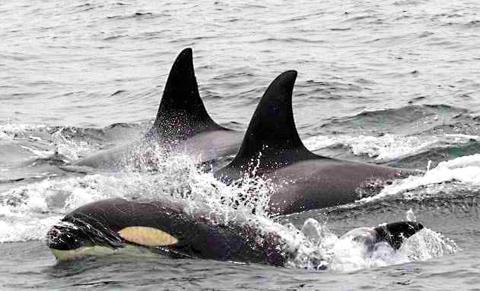High-pitched, eerie and yet distinct, the sound of a voice calling the name “Amy” is unmistakable. But this isn’t a human cry — it’s the voice of a killer whale called Wikie.
New research reveals that orcas are able to imitate human speech, in some cases at the first attempt, saying words such as “hello,” “one, two” and “bye bye.”
The study also shows that the creatures are able to copy unfamiliar sounds produced by other orcas — including a sound similar to blowing a raspberry .

Photo: AP
Scientists say the discovery helps to shed light on how different pods of wild killer whales have ended up with distinct dialects, adding weight to the idea that they are the result of imitation between orcas.
The creatures are already known for their ability to copy the movements of other orcas, with some reports suggesting they can also mimic the sounds of bottlenose dolphins and sea lions.
SOUND MAKERS

Photo: AP
“We wanted to see how flexible a killer whale can be in copying sounds,” said Josep Call, professor in evolutionary origins of mind at the University of St Andrews and a co-author of the study. “We thought what would be really convincing is to present them with something that is not in their repertoire — and in this case ‘hello’ [is] not what a killer whale would say.”
Wikie is not the first animal to have managed the feat of producing human words: dolphins, elephants, parrots, orangutans and even beluga whales have all been captured mimicking our utterances, although they use a range of physical mechanisms to us to do so. Noc, the beluga whale, made novel use of his nasal cavities, while Koshik, an Indian elephant jammed his trunk in his mouth, resulting in the pronouncement of Korean words ranging from “hello” to “sit down” and “no.”
But researchers say only a fraction of the animal kingdom can mimic human speech, with brain pathways and vocal apparatus both thought to determine whether it is possible.
“That is what makes it even more impressive — even though the morphology [of orcas] is so different, they can still produce a sound that comes close to what another species, in this case us, can produce,” said Call.
He poured cold water, however, on the idea that orcas might understand the words they mimic. “We have no evidence that they understand what their ‘hello’ stands for,” he said.
Writing in the journal Proceedings of the Royal Society B: Biological Sciences, researchers from institutions in Germany, UK, Spain and Chile describe how they carried out the latest research with Wikie, a 14-year-old female orca living in an aquarium in France. She had previously been trained to copy actions performed by another orca when given a human gesture.
After first brushing up Wikie’s grasp of the “copy” command, she was trained to parrot three familiar orca sounds made by her three-year old calf Moana.
Wikie was then additionally exposed to five orca sounds she had never heard before, including noises resembling a creaking door and the blowing a raspberry.
KEEP IT SIMPLE
Finally, Wikie was exposed to a human making three of the orca sounds, as well as six human sounds, including “hello,” “Amy,” “ah ha,” “one, two” and “bye bye.”
“You cannot pick a word that is very complicated because then I think you are asking too much — we wanted things that were short but were also distinctive,” said Call.
Throughout the study, Wikie’s success was first judged by her two trainers and then confirmed from recordings by six independent adjudicators who compared them to the original sound, without knowing which was which.
The team found that Wikie was often quickly able to copy the sounds, whether from an orca or a human, with all of the novel noises mimicked within 17 trials. What’s more, two human utterances and all of the human-produced orca sounds were managed on the first attempt, although only one human sound — “hello” — was correctly produced more than 50 percent of the time on subsequent trials.
The matching was backed up through an analysis of various acoustic features from the recordings of Wikie’s sounds.
While the sounds were all made and copied when the animals’ heads were out of the water, Call said the study shed light on orca behavior.
“I think here we have the first evidence that killer whales may be learning sounds by vocal imitation, and this is something that could be the basis of the dialects we observe in the wild — it is plausible,” said Call, noting that to further test the idea, trials would have to be carried out with wild orcas.
Diana Reiss, an expert in dolphin communication and professor of psychology at Hunter College, City University of New York, welcomed the research, noting that it extends our understanding of orcas’ vocal abilities, with Wikie able to apply a “copy” command learned for imitation of actions to imitation of sounds.
Irene Pepperberg, an specialist in parrot cognition at Harvard University, also described the study as exciting, but said: “A stronger test would have been whether the various sounds produced could be correctly classified by humans without the models present for comparison.”

Aug. 25 to Aug. 31 Although Mr. Lin (林) had been married to his Japanese wife for a decade, their union was never legally recognized — and even their daughter was officially deemed illegitimate. During the first half of Japanese rule in Taiwan, only marriages between Japanese men and Taiwanese women were valid, unless the Taiwanese husband formally joined a Japanese household. In 1920, Lin took his frustrations directly to the Ministry of Home Affairs: “Since Japan took possession of Taiwan, we have obeyed the government’s directives and committed ourselves to breaking old Qing-era customs. Yet ... our marriages remain unrecognized,

During the Metal Ages, prior to the arrival of the Dutch and Chinese, a great shift took place in indigenous material culture. Glass and agate beads, introduced after 400BC, completely replaced Taiwanese nephrite (jade) as the ornamental materials of choice, anthropologist Liu Jiun-Yu (劉俊昱) of the University of Washington wrote in a 2023 article. He added of the island’s modern indigenous peoples: “They are the descendants of prehistoric Formosans but have no nephrite-using cultures.” Moderns squint at that dynamic era of trade and cultural change through the mutually supporting lenses of later settler-colonialism and imperial power, which treated the indigenous as

An attempt to promote friendship between Japan and countries in Africa has transformed into a xenophobic row about migration after inaccurate media reports suggested the scheme would lead to a “flood of immigrants.” The controversy erupted after the Japan International Cooperation Agency, or JICA, said this month it had designated four Japanese cities as “Africa hometowns” for partner countries in Africa: Mozambique, Nigeria, Ghana and Tanzania. The program, announced at the end of an international conference on African development in Yokohama, will involve personnel exchanges and events to foster closer ties between the four regional Japanese cities — Imabari, Kisarazu, Sanjo and

By 1971, heroin and opium use among US troops fighting in Vietnam had reached epidemic proportions, with 42 percent of American servicemen saying they’d tried opioids at least once and around 20 percent claiming some level of addiction, according to the US Department of Defense. Though heroin use by US troops has been little discussed in the context of Taiwan, these and other drugs — produced in part by rogue Chinese Nationalist Party (KMT) armies then in Thailand and Myanmar — also spread to US military bases on the island, where soldiers were often stoned or high. American military policeman